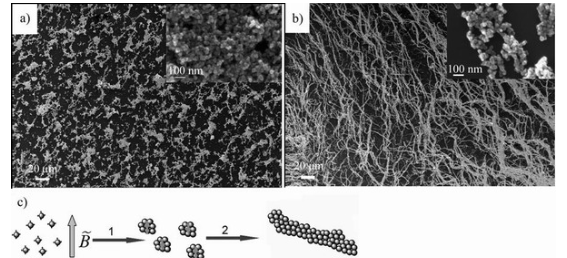A layer of pre-synthesized Fe3O4 aqueous suspension is subjected to an alternating-current magnetic field which is normal to the substrate. Ultra-long mesoscopic fibers of nanoparticles aggregates, coupled with a transition from quasi-1D to amorphous self-assembly, are observed with the field intensity increasing. Colloidal samples with different surface charges are experimentalized and the surface-controlled morphological diversity is found. Based on the experiments, a conceivable mechanism is proposed involving electrostatic interaction and magnetic moments interaction.

Figure . a) Scanning electron microscopy (SEM) image of Fe3O4 nanoparticle aggregates after solvent evaporation in the absence of an alternating-current magnetic field. Inset: Magnified image. b) SEM image of pattern formation of electrostatically stabilized Fe3O4 nanoparticlesunder an alternating-current magnetic field. The excited current is 170 A, which is the minimum of our equipment. For subsequent magnetic property measurement, the concentration is higher than 28 mgmL-1, at approximately 0.5 mgmL-1. c) Formation of microfibers from an electrostatically stabilized colloidal suspension under an alternating-current magnetic field. 1) Breakdown of electric double layer leads to aggregate formation; alternating magnetic field destroys the electric double layers. 2) There exist parallel or antiparallel magnetic moments inside clusters; dipolar attraction leads to the formation of meso-fibers. Jianfei Sun, Yu Zhang, Zhongping Chen, Jie Zhou, Ning Gu.Fibrous Aggregation of Magnetite Nanoparticles Induced by a Time-Varied Magnetic Field , Angew.Chem.Int.Ed. 2007, 46,4767-4770

